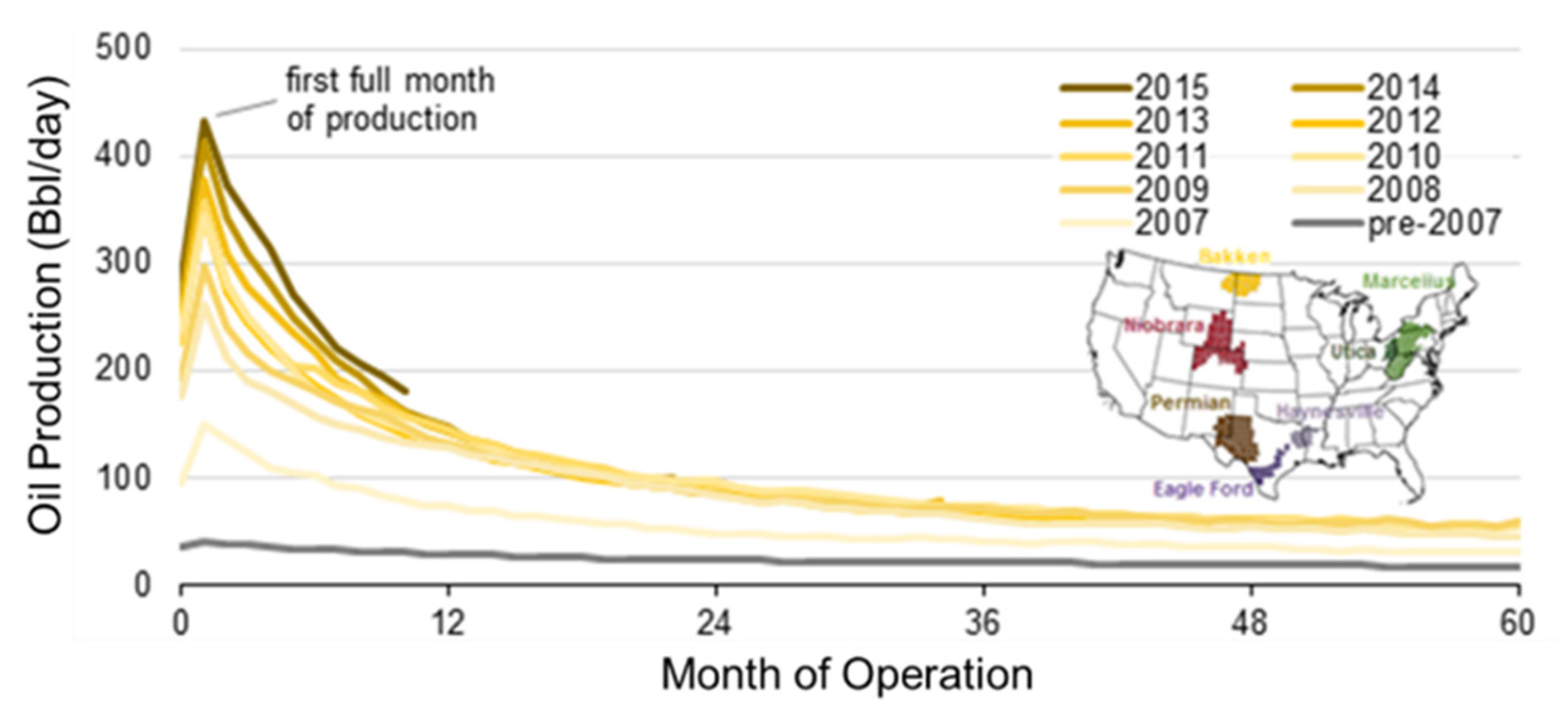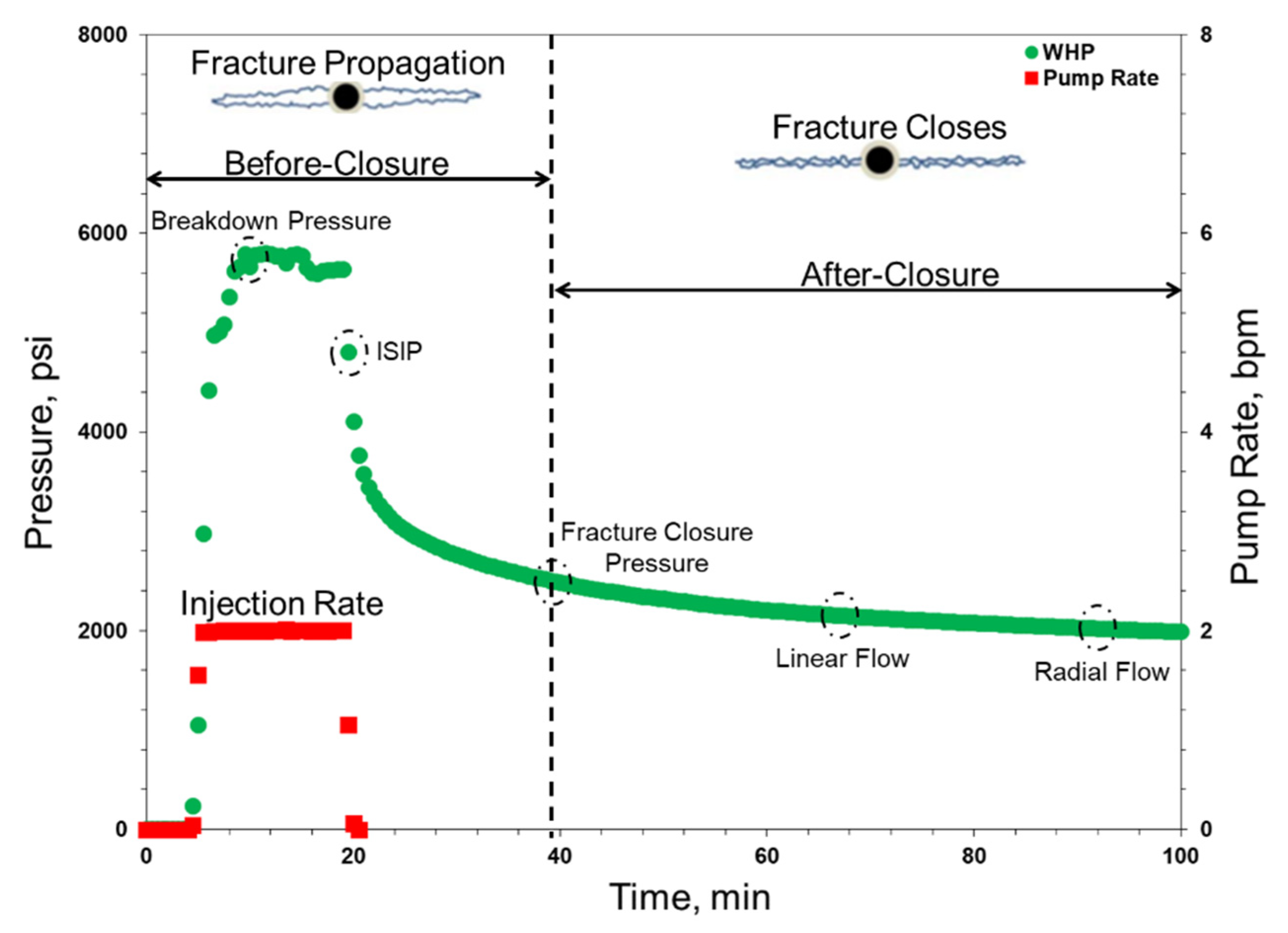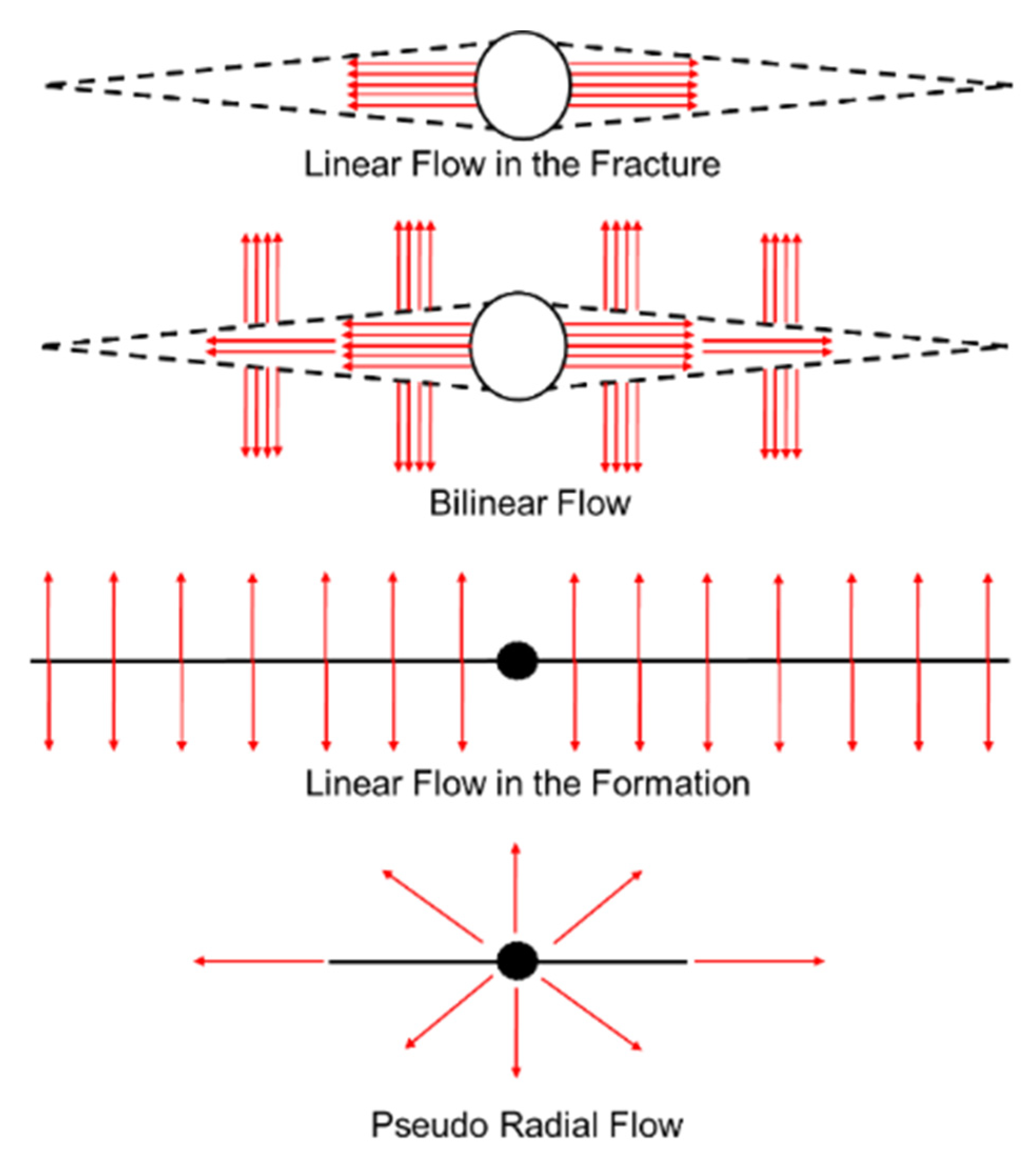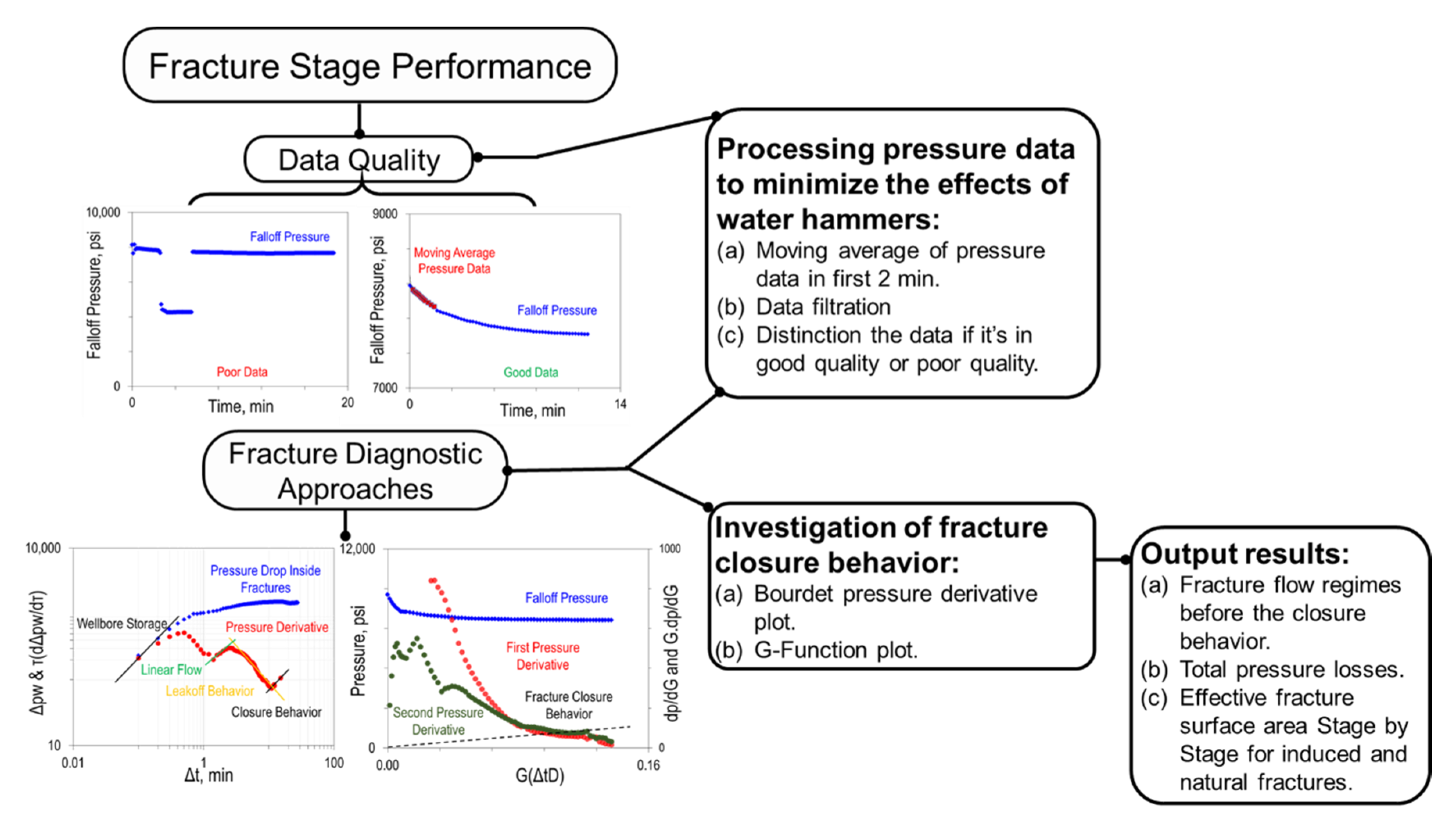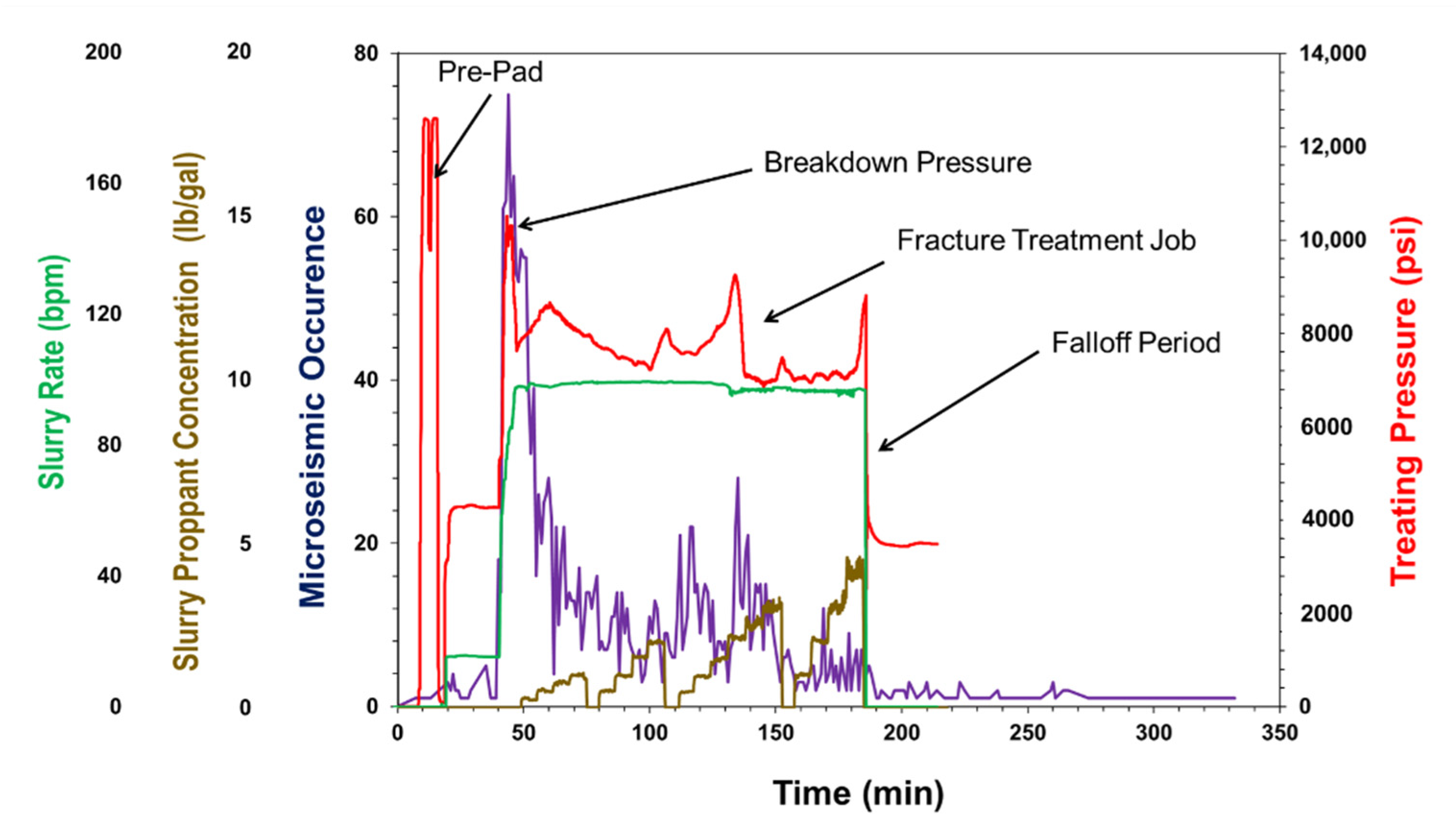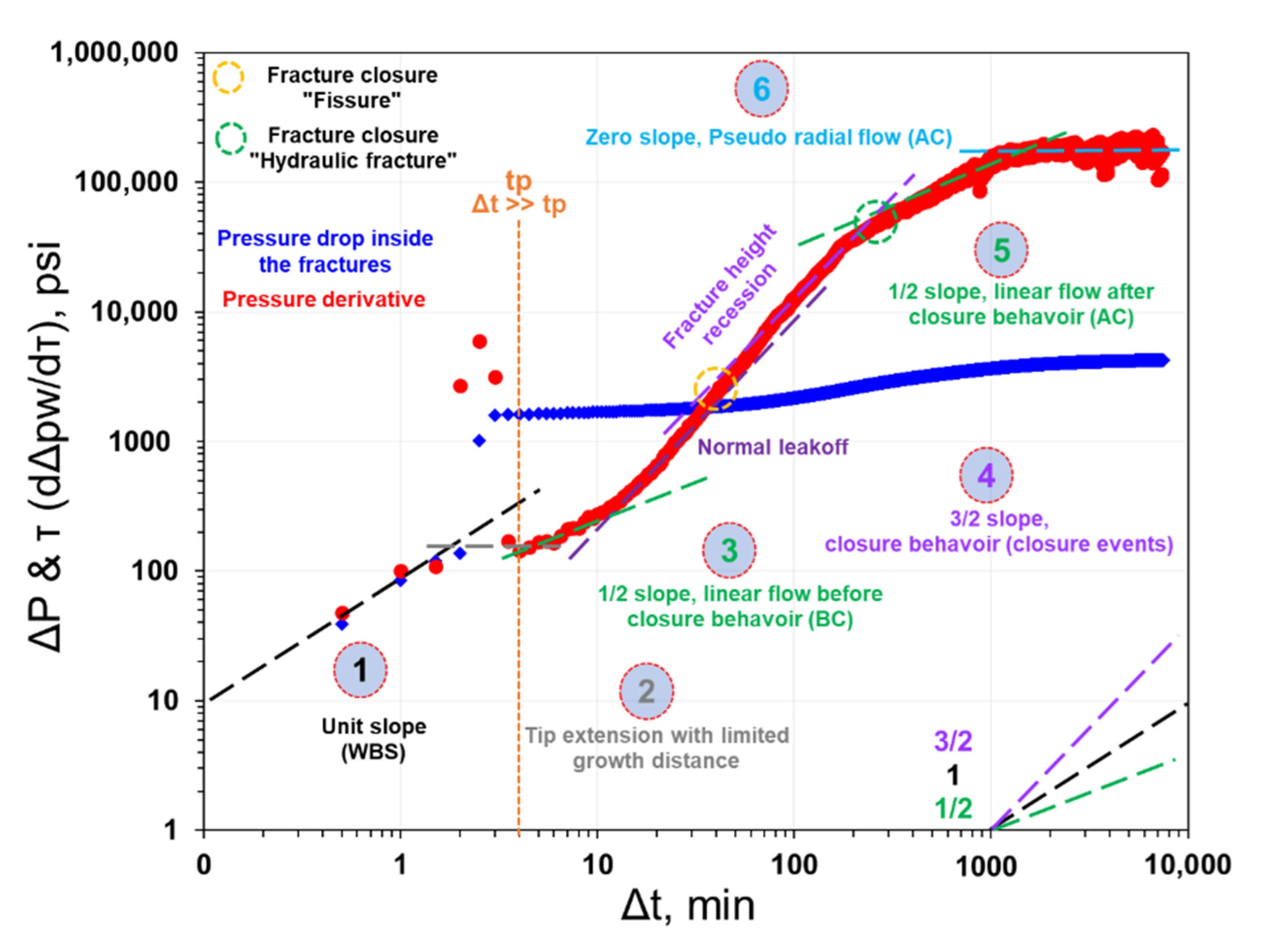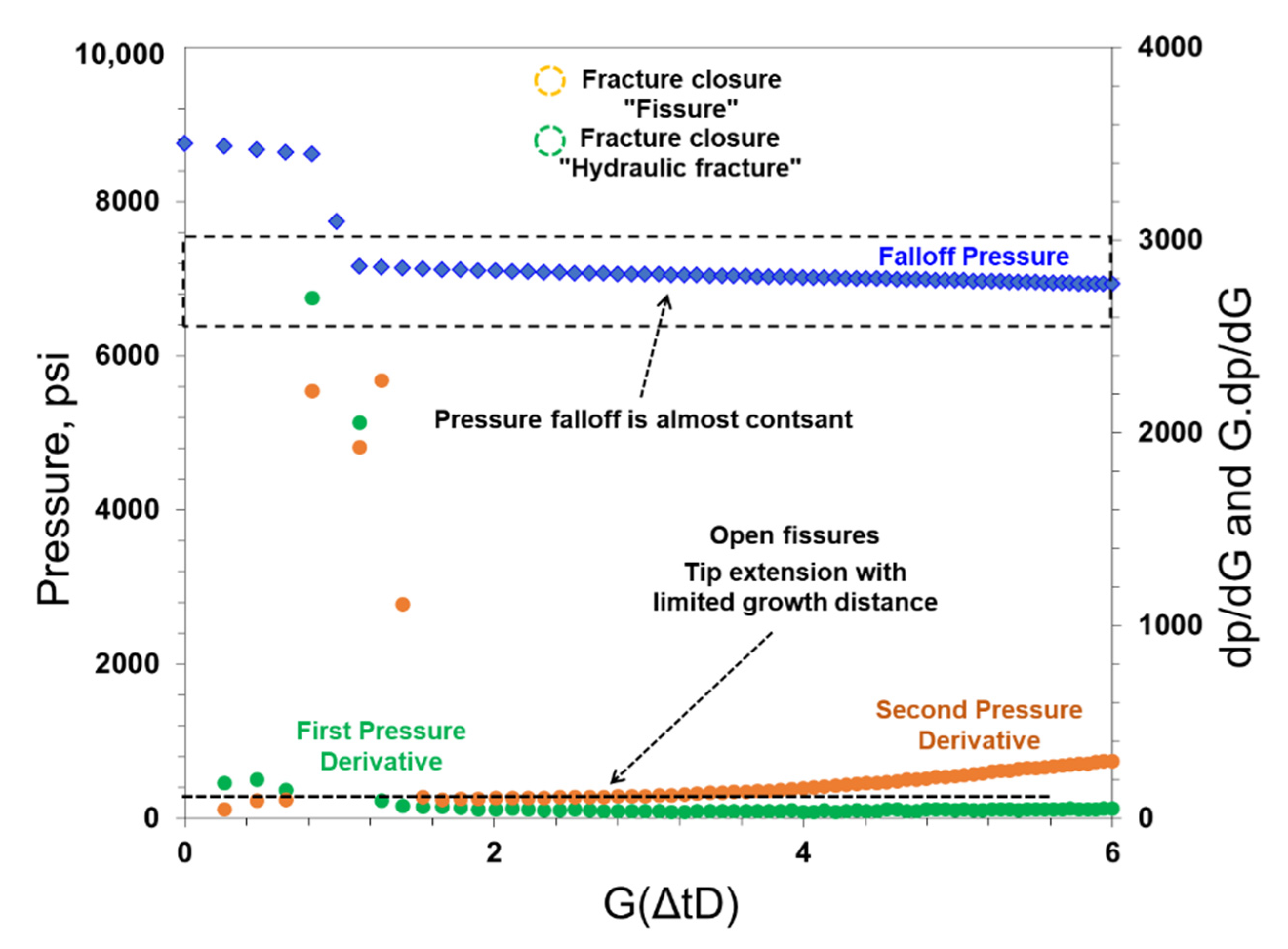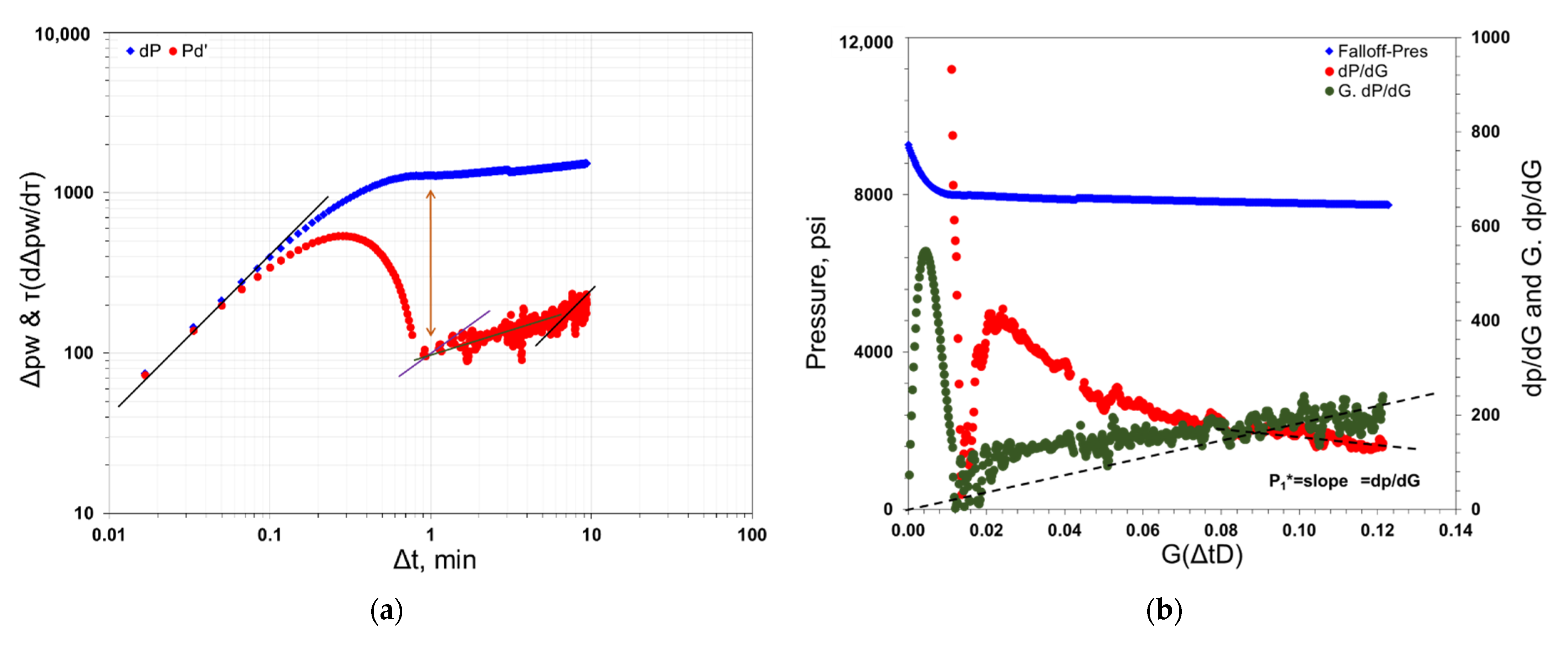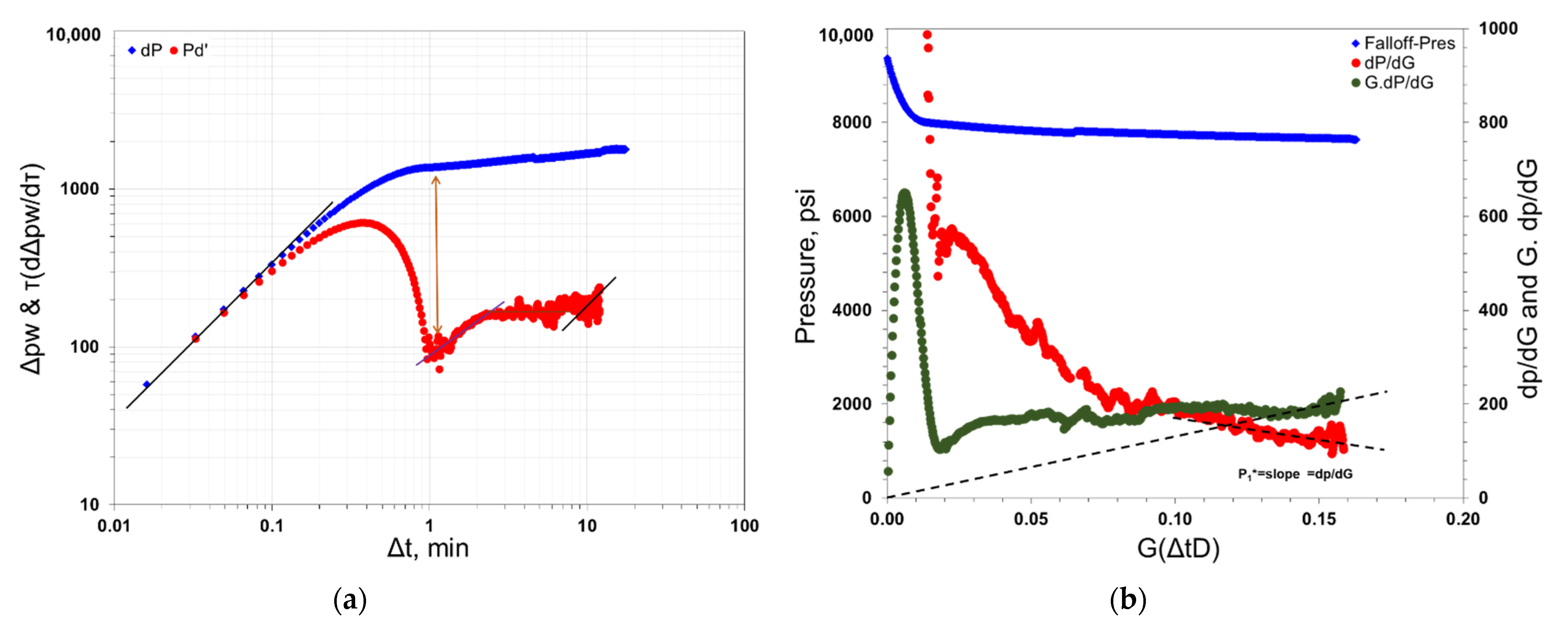DFITs have been widely used in the oil and gas industry over the last 20 years. This approach is based on the pressure transient data procured immediately after fracture treatments to obtain a reliable assessment of fracture and reservoir properties. A DFIT is a standard well testing technique for ultra-low-permeability formations, where a traditional pressure transient test, such as a buildup test, is impractical. A DFIT analysis does not require a long shut-in time to reach the radial flow regime.
The pressure falloff data are analyzed in a DFIT to estimate the in-situ stress, fluid efficiency, leak-off coefficient, reservoir properties, and net pressure, which are the critical factors used to design and implement a successful main fracture treatment. A DFIT provides the representative properties of an undamaged formation since the test creates a large area of investigation that can extend beyond the damaged near-wellbore zone. The results from a DFIT can be used in several ways: (a) characterizing in-situ stresses and fracture compliance [
20], (b) modeling hydraulic fracture propagation [
21], (c) designing fracture treatment jobs [
22], (d) modeling reservoir simulation [
23], and (e) post-fracture treatment analysis [
24]. This application can also be utilized in geologic carbon sequestration, nuclear waste repositories, and geothermal energy exploitation [
17,
25,
26].
A DFIT implementation and interpretation should be studied in detail before any field execution or analysis. We have presented lessons learned and recommendations that may help operators design the optimum fracture jobs.
4.1. DFIT Design and Tactics
A typical DFIT operation pumps a small volume of the treatment fluid, such as water, without proppant at a constant rate for a short period of approximately 3–5 minutes. The injection pressure increases above the reservoir fracturing pressure, or breakdown pressure, creating a short artificial fracture in the target layer. The leak-off behavior is small during the injection period, and no filter cake forms on the fracture wall. The pressure falloff data is a recorded function during shut-in time immediately after the treatment. The injected fluid begins to leak-off into the formation until the fracture wall comes into contact, also called closure. The pressure falloff period recorded in the case studies we analyzed was extended for days or even weeks to observe the radial flow regime, depending on the reservoir characteristics.
Figure 2 displays a typical pressure profile of a DFIT in the absence of natural fractures and weak planes. Two distinct periods of before and after closure (BC and AC) were analyzed to characterize the properties of the created fractures and reservoirs. These two periods were separated by the fracture closure event, which is the primary outcome and supplies us with the fracture closure pressure, or minimum in-situ stress. The fracture and reservoir properties were obtained by analyzing the typical flow regimes observed during the BC, before closure for fracture-dominated, and AC, after closure for reservoir-dominated, respectively (
Figure 3).
The conditions of modeling in unconventional reservoirs are more complex than in conventional formations. Significant conflict exists on how to model the fracture closure behavior since most of the models assume that the fracture surface is perfectly smooth; however, fractures exist everywhere in the subsurface in the form of small-scale cracks and fissures, and large-scale joints and faults. The mechanical resistance and fluid transport properties found in unconventional formations are complicated and controlled by several factors, such as in-situ stress, compliance or stiffness, rock mineralogy, fracture-surface roughness, treatment fluid pressure inside the fractures, and leak-off rate [
11,
20,
27]. A proper DFIT model must account for the effects of pressure-dependent leak-off and dynamic fracture compliance to precisely capture the fracture pressure response and obtain a realistic estimation of the fracture closure pressure and fluid leak-off behavior [
20,
28]. These parameters are crucial factors necessary for calculating the fracture surface contact areas to obtain proper hydraulic fracture modeling and accurate post-treatment assessment.
Investigating compelling field evidence using a downhole measurement that indicates what exactly occurs in the subsurface is paramount.
Figure 4 illustrates the tiltmeter measurements of well #2B from the Gas Research Institute/Department of Energy M-site, which is defined as an indication of fracture displacement or fracture width [
29].
Wang and Sharma [
20] used recorded data to explain the relationship between normalized tilt and formation pressure (
Figure 4). The data for this downhole field measurement were recorded and gathered immediately after the end of the several week-long test. The
Y-axis presents the normalized tilt calculated by dividing each tiltmeter measurement by the maximum fracture displacement. The data were plotted vs. the wellbore pressure to generate the diagnostic plot (
Figure 4), demonstrating a direct measurement of the rock deformation during the fracture closure behavior. The results indicate that the pressure falloff data response on a normalized tilt vs. formation pressure plot (
Figure 4) is proportional to the fracture compliance (Equation (1), or inversely proportional to fracture stiffness, and the fracture closure behavior is a function of average displacement and fracture volume.
The fracture volume is proportional to the average fracture width as the pressure continues to decrease, and two distinct periods are indicated on the diagnostic plot: (1) The trend of the pressure falloff data is a linear decline until the point of measured pressure inside the fracture, or closure pressure, is greater than 21 MPa (3046 psi). At this point, the fractures are still open, the stiffness factor is constant, and the surface area remains constant until the fracture wall comes into contact, or closure. The fracture geometry can then be estimated directly using
Table 2. (2) The pressure falloff data begin to deviate from a straight line at the inflection point on the plot, where the closure pressure is marked with a dashed green line; therefore, the fracture stiffness increases gradually, as a result of the fracture closure on the asperities of the fracture edges or tips (
Table 1).
Table 1.
Comparison of different diagnostic methods for fracture treatment performance analysis.
Table 1.
Comparison of different diagnostic methods for fracture treatment performance analysis.
| a. Production Data Analysis as a Diagnostic Method: |
| Pros | Cons | Results | Authors |
The data are readily available at low costs, and their analysis is straightforward. This application is critical for using historical production data for various purposes:
- (a)
Characterize reservoir and well stimulation properties, - (b)
Predict production performance for development plans and reserve estimations.
Production data analysis is useful for checking the consistency of the data and identifying the flow regimes over time. There are a couple of ways to apply production data techniques:
- (a)
Type curve analysis, - (b)
Straight line (flow regime) analysis, - (c)
Analytical and numerical simulation, - (d)
Empirical methods to quantify the hydraulic fracture performance at different unconventional well life stages.
Production analysis is a tool to study linear flow regimes when assessing the productivity and effectiveness of completion designs.
The impact of fracture-hit and offset stages can also be evaluated. | High-frequency measurements are required to obtain a reasonable analysis. The results suffering from some degree of uncertainty; therefore, more information is required, such as geology, phase behavior, and completion practices. This information needed is more complex compared to other approaches. Traditional production data analysis assumes that all clusters are similar, which appears to be an oversimplification of the problem. All production data analysis methods are non-uniqueness associated with well and reservoir properties; therefore, the different methods must be validated and cross-checked. The production data approaches for conventional rate transient methods need further modifications to analyze the MSHW data. Production data analysis does not offer any procedures for quick and measured adjustments of completion designs and production operations.
| Fracture permeability. Conductivity. Storage coefficient. Fracture half-length. SRVs. Hydrocarbon in place. Reservoir permeability. Thickness product. Skin. Performance forecast.
| [1,14,24,25,30,31] |
| b. Micro-Seismic Fracture Imaging/Mapping |
| Pros | Cons | Results | Authors |
Micro-seismic imaging provides the best resolution and lowest uncertainties when characterizing fracture geometries in most cases. Micro-seismic mapping can be coupled with real-time simulations to accurately predict fracture growth in the target zone. This combination can be utilized to assess the effectiveness of flushing an unexpected screen-out, imaging proppant placement, synthetic micro-seismic event prediction, and fracture geometry control. Micro-seismic imagery is also helpful during postmortem well performance analysis to:
- (a)
Calibrate numerical simulations, - (b)
Optimize stimulation design, - (c)
Investigate frac-hit phenomena, - (d)
Test new fracturing procedures, - (e)
Assess well drainage patterns, - (f)
Optimize economics, such as Net Present value (NPV) and Rate of Return (ROR).
| This technology is not widely used due to its high cost. This application is associated with a few uncertainties due to source mechanisms:
- (a)
Receiver-coupling resonances, such as improper sensor couplings with rock properties, including velocity-model limitations, formation anisotropy, noise, and mislocation. - (b)
The interference of fluid leak-off and stress effects in some formations, such as shale plays.
Fracture geometries obtained from micro-seismic monitoring may not be accurate enough in certain situations; therefore, the geometries must be validated and cross-checked with other diagnostic tools. The extent of fractures parallel to the lateral might be difficult to interpret from micro-seismicity alone, such as in the case of micro-seismicity vs. dimensions. Micro-seismic imaging cannot provide accurate information on individual fractures and cracks, or whether they are open, closed, or propped/unpropped. It is not clear why micro-seismics may not detect the tensile failure at the advancing tip of a hydraulic fracture.
| Fracture direction. Fracture dimension:
- (a)
Fracture half-length, - (b)
Fracture height.
Fracture complexity. SRVs.
| [4,16,31,32,33,34] |
| c. Transient Pressure Analysis “DFIT and Post-Treatment Falloff Pressure” |
| Pros | Cons | Results | Authors |
It is a simple approach that only requires shut-in pressure vs. time. The data are recorded right after fracture treatments with no additional cost. It is a unique method to assess the state of created fractures, whether they are open, closed, or propped. It does not require long periods of shut-in data, as required in conventional buildup tests. A half-hour period for pressure recordings after the main fracturing treatment would be enough to reliably obtain falloff pressure analysis and diagnostic plots to determine:
- (a)
Effective contact of natural fracture surface area, - (b)
Effective contact of induced fractures surface area.
This technique can be used at any time during the life of the well and can also be integrated with intelligent production studies. This technique may facilitate the real-time evaluation of the created contact areas between the well and reservoir at each fracture stage, representing the success of a fracturing treatment job. The method provides the flow regimes and fracture/reservoir behaviors before and after closure. Evaluating individual fracture stages through this technique can assist in stage-by-stage treatment job optimization and further design improvements.
| The application of fracture falloff pressure analysis is still in its infancy, and its theory is based on the assumptions of DFIT:
- (a)
The whole surface of created fractures/cracks would contribute to the fluid flow. Further research is necessary to improve the current effective well/fractures contact area workflow estimation fracture.
We recommend the inclusion of proppant-impact-factors (PIFs) in the estimation of the effective contact areas to improve the DFIT assumptions. It may not be used independently as an accurate diagnostic tool to assess fracture network growth. It is recommended that this tool be integrated with other methods, such as:
- (a)
Micro-seismic, where the fracture height is required for area estimation, given by MS, - (b)
Production logging data, - (c)
Fiber-optic information, - (d)
Rate transient analysis.
This technique has not yet been used for real-time fracturing treatment optimizations. A low-pressure gauge resolution can cause inaccurate diagnostic plots and unreliable results. We recommend a measurement of the shut-in pressure period at a time interval of one second using high-resolution pressure gauges, which can assist in solving data quality issues and minimize the effects of water hammers.
| | [9,13,14,20,28] |
This information coincides with downhole measurements but is not a parameter in the available DFIT models; therefore, this application assists us with measuring the appropriate closure pressures and provides more information on the mechanics of the created hydraulic fractures, such as if they are open or closed. This information may assist us in developing DFIT assumptions by adding proppant-impact-factors (PIFs), which can be used in the post-treatment pressure falloff data analysis to estimate an effective contact fracture surface area, such as the propped fracture area per cluster.
4.2. Fundamentals of DFIT
The leak-off behavior term was introduced in Nolte’s work (1979, 1986) [
35,
36], where he pioneered DFIT as a reliable test method before executing main fracture jobs. A poroelastic closure model was used to describe the pressure falloff behavior when fracturing fluid leak-off entered the fractures and formations. Equations (2)–(10) are used for analyzing a DFIT to capture normal leak-off behavior. This analysis is based on the following assumptions, which are assumed in several models: (1) power-law fracture growth, (2) negligible spurt loss, (3) constant fracture surface area immediately after the end of the test if there is constant leak-off area and constant fracture compliance or stiffness, and (4) Carter’s leak-off model, which defines one-dimensional fluid leak-off across a constant pressure boundary. The leak-off behavior is not pressure-dependent, and the solution to the diffusivity equation predicts that the leak-off rate will scale with the inverse of the square root of time.
These assumptions may be realistic due to the characterization of the fracturing fluids and unconventional formations; therefore, Nolte’s technique may not work for unconventional formations and may yield overestimated results in parameters such as fluid efficiency, leak-off coefficient, and storage coefficient. This technique is a reliable application under some circumstances and is derived based on the G-function approach (Equation (2)). The pressure and G-function time are analyzed on log-log graphs to obtain the fracture closure point and other parameters, such as fluid efficiency and leak-off coefficient.
where,
is the pressure at the end of pumping,
is the pressure recorded at the surface during the falloff period, and
is the dimensionless time defined by:
is the superposition time defined by:
With pumping time , falloff period , productive fracture ratio , fracture height , propped height , leak-off coefficient , and fracture compliance , : at the closure point.
The pressure derivative equation is defined by:
where the g-function of time is approximated by:
is the loss-volume function, approximated analytically by Nolte (1979, 1986) [
35,
36] with the bounding values of the area exponent,
and
is
, see
Table 2.
Castillo [
37] later introduced a new G-function plot to address the assumption of pressure-dependent behavior by linearizing the relationship between the pressure falloff and time during the closure behavior. The relation is the time, such as the G-function time and the square root of time, on the
X-axis vs. falloff pressure and the pressure derivative on the
Y-axis. This approach reduces the uncertainty of estimating fracture fluid efficiency and the leak-off coefficient, while overestimated outcomes have resulted from Nolte’s method. The diagnostic plot estimates accurate pressure parameters, such as instantaneous shut-in pressure “ISIP,” closure pressure “Pc,” and Nolte match pressure “
”.
Barree and Mukherjee [
38] presented several types of abnormal leak-off behaviors: (a) natural fracture opening or pressure-dependent leak-off, (b) fracture tip extension or recession, (c) height recession, (d) pressure-dependent fracture compliance, and (e) transient flow in the fracture. The authors developed Nolte’s work (1979, 1986) [
35,
36] for various closure behavior types and removed the ambiguity associated with understanding the complex fracture networks. The diagnostic plots allow us to predict an accurate estimation of the in-situ stress, fluid efficiency, leak-off coefficient, and pressure parameters. The G-function plot in the proposed models is the relationship between the following terms: falloff pressure,
, first pressure derivative,
, and second pressure derivative,
, on the
Y-axis vs. the G-function time on the
X-axis. The closure event is the point where the curve deviates from the straight line. Equations (11) through (13) are used to determine the primary outcomes, as listed in
Table 3. This method enables us to identify the proper leak-off behavior for accurately estimating the hydraulic fracture geometries.
Table 3.
Primary outcomes from a DFIT based on stipulated fracture geometry.
Table 3.
Primary outcomes from a DFIT based on stipulated fracture geometry.
| Results | Fracture Models | Equation |
|---|
| PKN | KGD | Radial | |
|---|
| | | | (11) |
| | | | (12) |
| | | | (13) |
where,
, closure time,
, Young’s modulus,
, total pumping volume, and
, the ratio of the average net pressure inside fractures to the maximum net pressure at the wellbore during the shut-in time (
Table 2).
A DFIT uses the basis of conventional mini-fracture treatments that focus on acquiring treatment design parameters, such as fluid efficiency and leak-off behavior; however, this application is subtly different for unconventional formation analysis. This approach is used to acquire significantly more information on the created fractures and formation properties, such as pore pressure, closure and fracture gradients [
11,
20,
28], process zone stresses [
6], transmissibility values [
39], leak-off mechanisms [
6], natural fracture properties [
6], fracture stiffness and un-propped fracture conductivity as a function of closure stress [
20], and stimulation complexity and net pressure [
40].
We can evaluate the properties of the main hydraulic fractures and natural fractures in a fracture treatment job by adopting the DFIT analysis method with no proppant. This method may not be ideal due to its tendency to ignore the impact of the proppant; however, it can be used with caution to evaluate post-treatment production and unconventional well performance.
4.3. DFIT Models: Before-Closure Analysis
Several analytical or semi-analytical models have been proposed for before-closure analysis (BC) [
35,
36,
41,
42,
43], where all BC models were based on two fundamental concepts underlying the proposed methodology: (1) a material balance equation before fracture closure, and (2) the diffusive flow in the formation after closure. These models were founded based on two main conditions: (1) the total injection volume is equal to the sum of the fracture volume and cumulative leak-off volume, and (2) the fracture volume is estimated from the linear elasticity theory and a 2D fracture geometry during the pressure falloff period.
Cramer and Nguyen [
44] reported that it would be rare to observe a normal leak-off behavior in the field, and closure behavior is commonly related to the abnormal leak-off concepts (
Figure 5); therefore, the BC analysis must correctly address abnormal leak-off behaviors and near-wellbore friction losses. Liu and Ehlig-Economides [
28] presented a model that was not limited to normal leak-off behavior compared to previous BC models [
20,
41,
42,
43]. These BC models relied on the assumptions of ideal leak-off behavior: (1) constant injection rate, (2) constant fracture surface area after shut-in, (3) creation of one main hydraulic fracture cluster without the effects of natural fractures, (4) constant fracture compliance during the operation, (5) assumption of similar fracture closure stresses for all stages, and (6) assumption that all injected fluid at the surface flows into the created fracture, meaning that the impact of the wellbore storage (WBS) is insignificant. Most current studies do not provide a quantitative discussion and do not address factors such as formation geology and mineralogy, resistance-dependent fluid distribution, and geomechanics parameters.
Table 4 summarizes DFIT analysis methods and the details of the fracture/reservoir property estimations from each period in a DFIT BC and AC.
Table 5 lists the different leak-off models commonly used to analyze a DFIT, while
Table 6 presents the outcomes from each model for several case studies. We have added our conclusions by summarizing the pros and cons of recently published models on abnormal leak-off behaviors (
Table 7).
We suggest developing the concept of DFIT to address this lack of a quantitative evaluation, allowing us to evaluate the post-treatment pressure falloff analysis in real-time fracture treatment job optimization. The accurate estimations of closure pressure, ISIP, and perforation and tortuosity friction losses can be obtained to prevent some far-field issues, such as well interventions, frac-hits, high apparent net pressure, and stress shadow. An effective evaluation of a stimulated formation before and during fracture treatment can identify optimal treatment design parameters for individual fracture stages.
